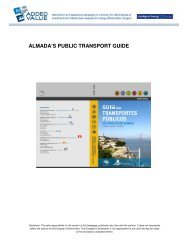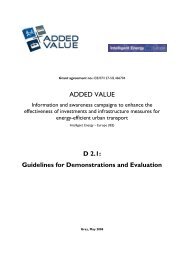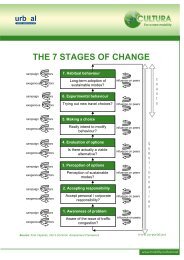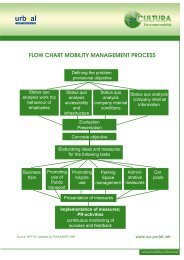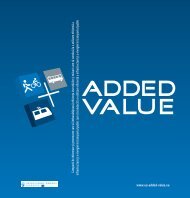SUMO - Eltis
SUMO - Eltis
SUMO - Eltis
Create successful ePaper yourself
Turn your PDF publications into a flip-book with our unique Google optimized e-Paper software.
30<br />
G – Satisfaction with the offer<br />
Satisfaction among participants with the travel options, offer or new behaviour that<br />
they have tested is a prerequisite for a repeated and hopefully permanent behavioural<br />
change. Satisfaction with the offer is a measure of how well the alternative fits the<br />
existing needs. This is true for both pure mobility management projects and for efforts<br />
that are based on management decisions at a company.<br />
Method<br />
Satisfaction can be measured through interviews with all or a few of the people who<br />
changed their behaviour during the test period. This provides useful information about<br />
how the travel alternatives could be improved to better meet the needs present.<br />
Examples of indicators and collection methods for satisfaction with the travel alternatives<br />
in the Test Traveller project are presented below.<br />
INDICATOR METHOD<br />
Percentage of people satisfied with the public transport option<br />
in the test situation.<br />
H – Permanent individual behaviour<br />
The overall goal in mobility projects is that the change in behaviour becomes permanent<br />
at the end of the project. Through questionnaire surveys or interviews with those who<br />
took part in the project after its completion, information can be obtained about enduring<br />
changes. These surveys should take place several months, sometimes preferably one<br />
year, after the end of the project to enable a better overview of permanent changes.<br />
Method<br />
In the same way as for experimental behaviour, it is important to have something to base<br />
a comparison on. The behaviour of each project participant, or selection of persons, is<br />
surveyed about one year after the end of the project. This could concern how many<br />
people permanently carpool to work one or more days per week or how many use cycle<br />
helmets when travelling to work a while after a cycle helmet campaign was conducted at<br />
the workplace.<br />
Examples of indicators and collection methods for permanent individual behaviour in the<br />
Test Traveller project are presented below.<br />
Percentage of public transport days per week a while after the<br />
project.<br />
I – System impact<br />
Measuring cause and effect relationships at a systems level is very interesting as this<br />
offers valuable feedback about the type of measure one should focus on.<br />
sumo – System for Evaluation of Mobility Projects<br />
Interviews / questionnaire<br />
surveys<br />
INDICATOR METHOD<br />
Number of people that travel by public transport at least 3 days<br />
per week a while after the project. This could be expressed as a percentage<br />
of employees.<br />
Interviews / questionnaire<br />
surveys<br />
Interviews / questionnaire<br />
surveys



